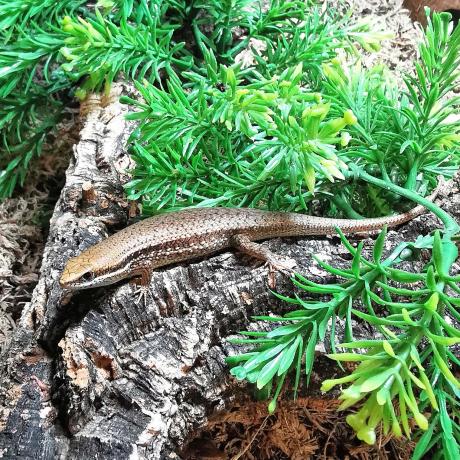

The Bronze Skink is a small species native to South and Southeast Asia. Males are easy to distinguish due to the orange colour on their throat and sides. Average size is 16cm snout to tip of the tail.
| Origin | Asia |
|---|---|
| Environment | Grassland and Shrubland |
| Adult Size | 16cm |
| Suitability | Novice |
| Lifespan | 8 Years + |
| Temperament | Docile but Skittish |
Bronze Skinks are a small species of lizard reaching around 16cm in total. Males have broader bodies than the females and can be distinguished by their orange coloured throat and neck area. Females tend to be slightly smaller and slimmer in body and don’t show as much bright colouration, both sexes are typically brown but with a beautiful iridescent sheen to them.
Being diurnal Bronze Skinks spend the majority of their day hunting for insects amongst the Forests and Grasslands of Southern and Northern Asia. Bronze skinks tend to favour this type of environment as they have plenty of shelter from predators such as snakes and birds, as well as a constant food and water supply.
Bronze skinks are super easy to care for and don’t take up too much space, however, they are a quick species and prefer not to be handled. Ideally, they would be best as a display pet rather than one to get out.
A pair or trio can be easily housed in a 3ft terrestrial vivarium or terrarium. Females can be kept together whereas it’s best not to keep too many males together as they can be territorial. Depending on what enclosure you go for lighting and heating can differ. For a terrarium set up, we would recommend a UVB 6% florescent light or equivalent. Heating can be provided either by using a dome light holder with a basking bulb connected to a dimming thermostat or basking lights can be placed into a Canopy top.
For a vivarium set up a heat, light can be added inside the vivarium preferably with a heat guard to prevent the skinks from burning themselves when basking or attempting to climb around the bulb. A fluorescent tube is also essential, T5 bulbs are much better. Temperature for this species can range from 80-85F during the day with a basking spot around 95F. Nighttime temperatures can drop around 65-70F. A digital thermometer will help you get an accurate temperature reading.
Coco fibre or a forest life substrate would be good to use as this will allow the skinks to express natural behaviours such as burrowing and digging. Logs, cork bark and other decors can be placed around the enclosure as both enrichment and also a place to hide and escape each other if needs be. If you’re looking to have a humid spot within the enclosure live moss can be placed either under a cave on the cool end of the enclosure or even just in one spot. Be sure to give the moss an occasional mist so that it doesn’t dry out.
Although you may not witness your skinks drink very often its best to leave a small water bowl inside the enclosure for when they need it.
When it comes to feeding don’t let their size fool you, though they may be small they have a ferocious appetite that can make feeding time all the more fun. Bronze skinks will eat a variety of different live food including crickets, locusts, cockroaches and mini mealworms. You can choose to use a mealworm bowl if you prefer too, however, scatter feeding with crickets and other food is best as you will see the skinks hunt down their prey.
If you’re not a massive fan of touching livefood we would recommend one of the Livefood Care Kits to house your critters in. This also proves beneficial as if you house your insects in something bigger and feed them up on Bug grub or Arcadia Insectfuel they will last longer and also be more nutritious for your skinks.
Last but certainly not least don’t forget to dust your livefood with a good quality Calcium supplement at least three times a week and also a Vitamin supplement twice a week too.